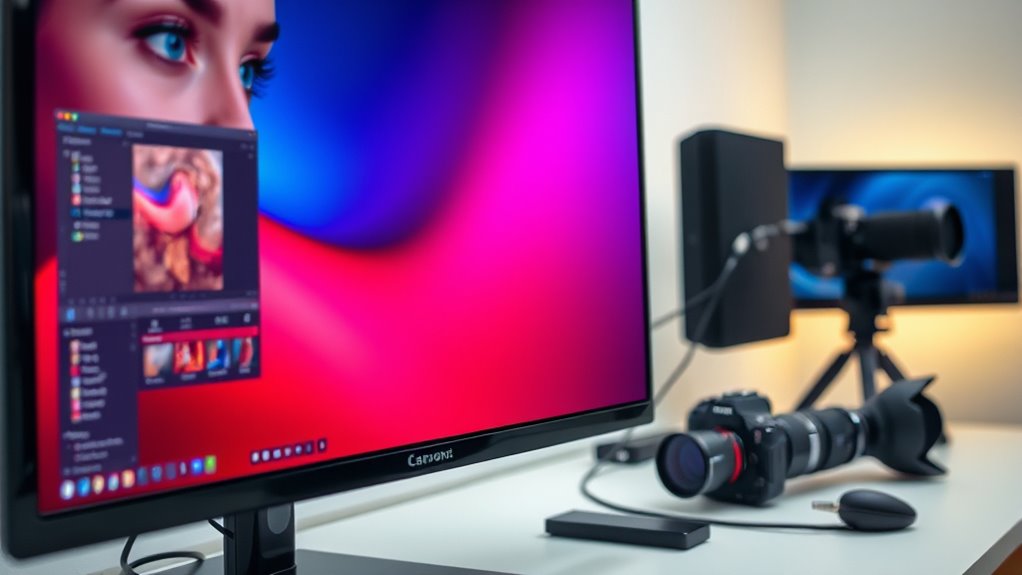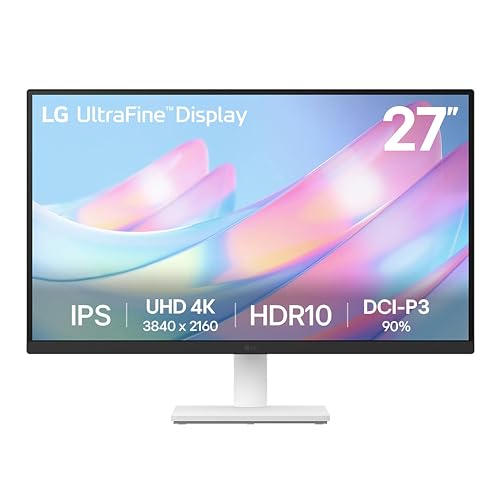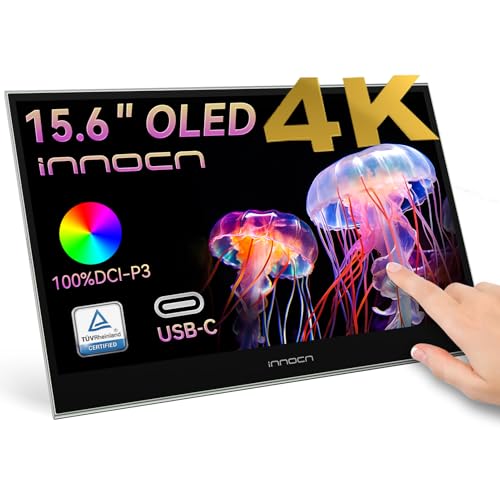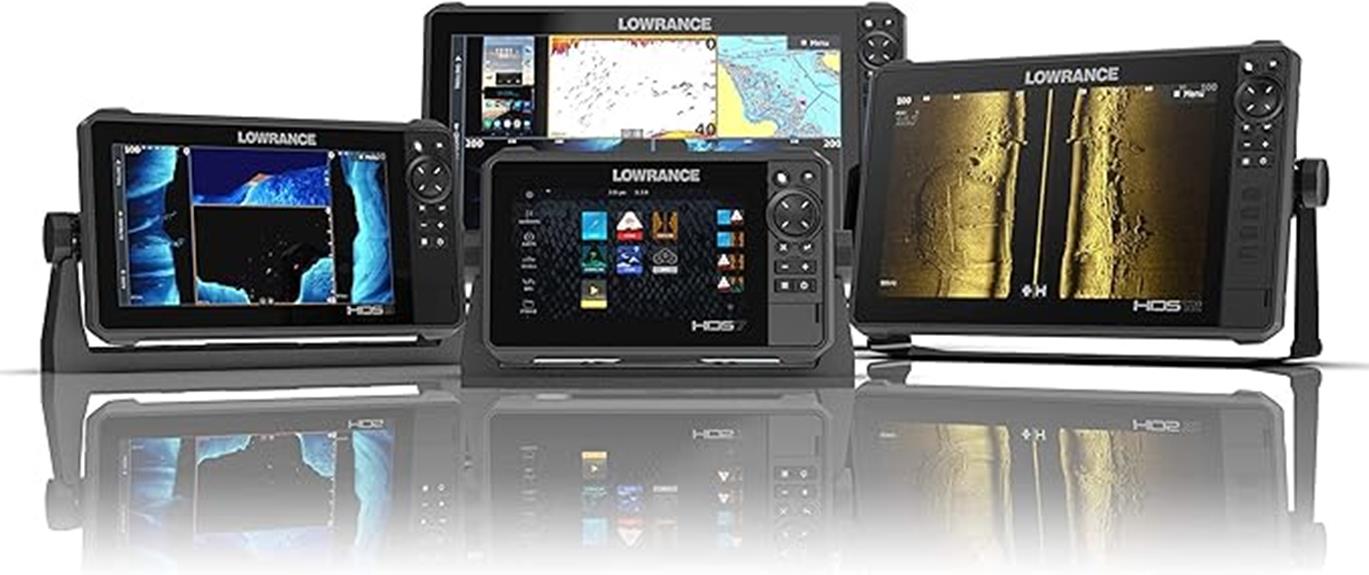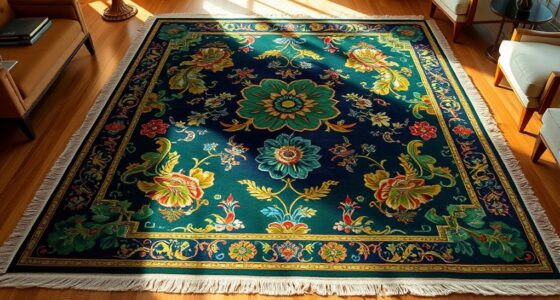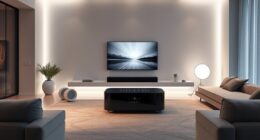If you’re looking for the best color‑accurate displays for photo editing, I recommend considering options like the ASUS ProArt series, BenQ PD2705U, and Apple Studio Display, which offer wide gamuts, factory calibration, and high resolutions. IPS panels ensure great viewing angles and excellent color accuracy. These monitors are reliable for professional workflows, providing precise visuals and consistent performance. Keep exploring to discover the top picks that fit your needs and budget.
Key Takeaways
- Look for monitors with wide color gamuts like Adobe RGB, DCI-P3, and sRGB for vibrant, true-to-life images.
- Prioritize factory calibration with low Delta E (<2) and professional certifications to ensure high color accuracy.
- Choose IPS or OLED panel technology for consistent, wide viewing angles and accurate color reproduction.
- Select high-resolution displays (4K or higher) to ensure detailed editing and precise color management.
- Consider connectivity options, ergonomic adjustments, and calibration support for seamless, long-term professional workflow.
ASUS ProArt Display PA248QV 24.1” WUXGA Monitor
If you’re a professional photo editor or a creative who demands precise color reproduction, the ASUS ProArt Display PA248QV is an excellent choice. Its 24.1-inch WUXGA screen offers a sharp 1920 x 1200 resolution with a 16:10 aspect ratio, ideal for detailed editing. The IPS panel provides wide viewing angles, ensuring consistent colors from any position. With 100% sRGB and Rec.709 coverage, plus DeltaE < 2, it delivers highly accurate, vivid colors straight out of the box. The monitor’s anti-glare coating and ergonomic adjustments make long editing sessions comfortable. Plus, its connectivity options and Calman verification guarantee reliable, professional-grade performance.
Best For: professionals in creative fields such as photo editing, graphic design, and digital content creation who require accurate color reproduction and high image clarity.
Pros:
- 100% sRGB and Rec.709 color space coverage for true-to-life hues
- Wide viewing angles with IPS panel for consistent colors from any position
- Adjustable ergonomic stand for comfortable long-term use
Cons:
- Limited to 1920 x 1200 resolution, which may be lower than some users prefer for ultra-high-definition work
- No built-in speakers or USB hub, requiring additional accessories
- Black color design may show fingerprints and smudges more visibly
ASUS ProArt 27” 4K HDR Professional Monitor (PA279CRV)
The ASUS ProArt 27” 4K HDR Professional Monitor (PA279CRV) stands out as an ideal choice for professional photo editors who demand exceptional color accuracy. Its 27-inch 4K UHD display features an IPS panel with 178° viewing angles, supporting 99% DCI-P3 and Adobe RGB color gamuts. Factory pre-calibrated to Delta E < 2 and Calman Verified, it guarantees precise color reproduction. The monitor offers versatile connectivity options, including USB-C with 96W Power Delivery, and has ergonomic features for comfortable long-term use. Weighing around 18 pounds, it’s a reliable, high-quality tool that combines technical excellence with user-friendly design—perfect for demanding creative workflows.
Best For: creative professionals and photo editors who require high color accuracy and extensive connectivity for demanding visual workflows.
Pros:
- 99% DCI-P3 and Adobe RGB color coverage for vibrant, accurate colors
- Factory pre-calibrated to Delta E < 2 for precise color reproduction
- versatile connectivity options including USB-C with 96W Power Delivery
Cons:
- Relatively heavy at approximately 18.25 pounds, which may affect portability
- Higher price point reflecting professional-grade features
- Limited to a 27-inch size, which might not suit those needing larger displays
ASUS ProArt Display PA278QV 27” WQHD Monitor
Photographers and graphic designers seeking precise color reproduction will find the ASUS ProArt Display PA278QV an excellent choice. This 27-inch WQHD IPS monitor delivers factory-calibrated accuracy with a ΔE of less than 2, supporting 100% sRGB and Rec. 709 color gamuts for consistent, vibrant images. Its adjustable ergonomic stand ensures comfortable long sessions, while the anti-glare coating reduces eye strain. Extensive connectivity options—including HDMI, DisplayPort, USB 3.0 ports, and more—make it versatile for any workflow. Designed for professionals, it combines high-resolution visuals with customizable color presets, making it a reliable, affordable choice for accurate photo editing.
Best For: Professional photographers, graphic designers, and content creators seeking precise and vibrant color accuracy for detailed editing tasks.
Pros:
- Factory-calibrated with a color accuracy ΔE < 2 for reliable true-to-life visuals
- Supports extensive color standards: 100% sRGB and Rec. 709 for vibrant, consistent images
- Adjustable ergonomic stand and anti-glare coating ensure comfort during long work sessions
Cons:
- Price may be higher compared to standard monitors without professional calibration features
- Limited to 27 inches, which might be small for users requiring larger displays for multitasking
- Power consumption and size may require dedicated desk space and power sources
ASUS ProArt Display PA247CV 23.8 Inch Monitor
For creative professionals who demand precise color accuracy, the ASUS ProArt Display PA247CV is an excellent choice. Its 23.8-inch IPS panel offers wide 178° viewing angles and Full HD resolution, delivering sharp, vibrant images. With 100% sRGB and Rec. 709 coverage, it guarantees accurate color reproduction right out of the box, thanks to factory calibration and Calman verification with Delta E < 2. It supports versatile connectivity, including USB-C with 65W Power Delivery, HDMI, DisplayPort, and USB 3.1 hub, making it compatible with various devices. Plus, it comes with a 3-month Adobe Creative Cloud subscription, enhancing its value for photo editing professionals.
Best For: creative professionals and digital artists who require precise color accuracy and versatile connectivity in a reliable monitor.
Pros:
- Covers 100% sRGB and Rec. 709 for accurate color reproduction
- Factory calibrated with Calman verification achieving Delta E < 2
- Multiple connectivity options including USB-C with 65W Power Delivery, HDMI, DisplayPort, and USB 3.1 hub
Cons:
- Full HD resolution may be less ideal for detailed or large-scale creative work compared to higher resolutions
- Slightly heavier at approximately 13.86 pounds, which might affect portability or mounting options
- Limited to a 23.8-inch screen size, which may be smaller than some professional displays
ASUS ProArt Display 27″ Monitor PA278CV
If you’re serious about color accuracy in photo editing, the ASUS ProArt Display 27″ Monitor PA278CV stands out as an excellent choice. It features a 27-inch WQHD (2560 x 1440) IPS panel with 178° wide viewing angles, ensuring consistent color from any perspective. Supporting 100% sRGB and Rec. 709, along with factory calibration verified by Calman (Delta E < 2), it guarantees precise color reproduction. Connectivity is versatile, including USB-C with 65W Power Delivery, DisplayPort, HDMI, and a USB 3.1 hub. Its ergonomic stand, eye-care features, and adaptive sync make it ideal for professional workflows demanding accurate and comfortable long-term use.
Best For: creative professionals and photographers who require precise color accuracy and versatile connectivity for their editing workflows.
Pros:
- Factory-calibrated with Calman verification achieving Delta E < 2 for exceptional color precision
- Supports extensive connectivity options including USB-C with 65W Power Delivery, DisplayPort, HDMI, and a USB 3.1 hub
- Ergonomic features such as height adjustment and eye-care technology for comfortable long-term use
Cons:
- 75Hz refresh rate may be less suitable for high-end gaming compared to faster gaming monitors
- WQHD resolution, while sharp, may not be as high as 4K displays for certain professional applications
- Limited to 27 inches, which might be small for users needing larger screen real estate
BenQ MA270U 27” 4K Monitor for MacBook® Pro/Air
The BenQ MA270U 27” 4K monitor stands out as an ideal choice for Mac users who need precise color accuracy for photo editing. Its 3840×2160 resolution paired with a P3 wide color gamut calibrated for Mac ensures vibrant, accurate colors right out of the box. The monitor connects seamlessly via a single USB-C port that delivers 90W power, supporting MacBook display expansion and charging devices like iPads or iPhones. With easy-to-access brightness and volume controls integrated into the Mac keyboard, plus versatile connectivity options, it offers both convenience and professional-grade color performance—making it a strong contender for serious photo editors.
Best For: Mac users seeking a high-resolution monitor with accurate color reproduction for photo editing and creative work.
Pros:
- Calibrated for Mac with P3 wide color gamut for vibrant, true-to-life colors
- Single USB-C connection with 90W power delivery simplifies setup and charging
- Adjustable stand offers ergonomic customization for comfortable long-term use
Cons:
- Relatively heavy at 30.5 pounds, which may require sturdy placement or added effort for adjustments
- Limited to Mac-specific controls, potentially less intuitive for Windows users
- Price may be higher compared to standard 4K monitors without Mac calibration features
ASUS ProArt 27” 5K HDR Professional Monitor (PA27JCV)
Professionals who demand precise color reproduction will find the ASUS ProArt 27” 5K HDR monitor to be an ideal choice. Its stunning 5120 x 2880 resolution and 27-inch size deliver exceptional detail, perfect for detailed editing work. The IPS panel provides 178° wide viewing angles, while the wide color gamut covers 99% DCI-P3, 100% sRGB, and 95% Adobe RGB, ensuring accurate color representation. Factory pre-calibrated to Delta E < 2 and Calman Verified, it guarantees professional-grade color accuracy. Additional features like ambient light sensors, USB-C with 96W Power Delivery, and a 3-year warranty make it a versatile, reliable tool for creative professionals.
Best For: professionals and creative content creators who require high-precision color accuracy and detailed 5K resolution for editing, design, and visual workflows.
Pros:
- Exceptional 5K resolution (5120 x 2880) delivers outstanding detail for precise editing.
- Wide color gamut coverage (99% DCI-P3, 100% sRGB, 95% Adobe RGB) ensures accurate color reproduction.
- Factory pre-calibrated to Delta E < 2 and Calman Verified for professional-grade color accuracy.
Cons:
- No integrated processor, relying on external devices for control.
- 27-inch size may be too small for some multi-monitor setups or immersive workflows.
- Premium price point may be a consideration for budget-conscious users.
INNOCN 27 Inch 4K Monitor with USB-C and HDR400
For photo editors who demand precise color reproduction, the INNOCN 27 Inch 4K Monitor stands out with its ∆E<2 color accuracy and 1000:1 contrast ratio. Its 3840×2160 UHD resolution and advanced IPS panel deliver sharp, vibrant images from any angle. The frameless design and 178° wide viewing angles enhance visual immersion, while HDR400 support improves contrast and color depth. Connectivity is versatile with USB-C (65W power), HDMI, DisplayPort, and a 3.5mm audio jack, making it compatible with various devices. Adjustable ergonomics, built-in speakers, and VESA mounting options ensure comfort and flexibility. This monitor offers professional-grade quality at an accessible price point.
Best For: professional photo editors and designers who require precise color accuracy and vibrant image quality.
Pros:
- Excellent color accuracy with ∆E<2 for true-to-life visuals
- High 3840×2160 UHD resolution and HDR400 support for vivid details
- Versatile connectivity options including USB-C, HDMI, and DisplayPort
Cons:
- Slightly heavy at 17.21 pounds, may require sturdy mounting
- Limited to 60Hz refresh rate, less ideal for fast-paced gaming
- No built-in USB hub or additional port features beyond basic connections
BenQ MA320U 32” 4K Monitor with USB-C for MacBook
Looking for a monitor that delivers precise, vibrant colors tailored for MacBook users? The BenQ MA320U 32” 4K monitor fits the bill perfectly. It features a sharp 3840×2160 resolution, calibrated specifically for MacBook with a wide P3 color gamut, ensuring accurate, consistent colors. Connectivity is seamless with dual USB-C ports that provide 90W power for charging your MacBook, plus HDMI options. The monitor’s ergonomic stand offers height, tilt, swivel, and pivot adjustments for comfort during long editing sessions. Designed for Mac compatibility, it allows easy control from your MacBook keyboard, making it a reliable, color-accurate choice for photo editing.
Best For: MacBook users seeking a 4K monitor with accurate color reproduction, versatile connectivity, and ergonomic design for professional editing and everyday use.
Pros:
- Calibrated for MacBook with wide P3 color gamut ensuring vibrant, accurate colors
- Dual USB-C ports delivering 90W power for seamless single-cable connection and charging
- Adjustable stand with height, tilt, swivel, and pivot for ergonomic comfort
Cons:
- May be pricier compared to standard 4K monitors without Mac-specific calibration
- Limited to Mac compatibility, potentially less versatile for non-Apple devices
- Requires a USB-C connection for full features, which may not be available on older devices
BenQ PD3205U 4K UHD Monitor (32″)
The BenQ PD3205U 4K UHD Monitor stands out as an ideal choice for photo editors who demand precise color accuracy and consistent image quality. Its 32-inch IPS panel is factory calibrated with a Delta E ≤3, covering 99% sRGB and Rec.709, ensuring vibrant, true-to-life colors. The monitor’s AQCOLOR technology and validation from CalMan and Pantone guarantee reliable color reproduction. Adjustable ergonomic features let me customize my workspace for comfort. With seamless connectivity options—HDMI, DisplayPort, USB-C supporting 65W power—it’s versatile for professional workflows. Built-in speakers and a USB hub enhance functionality, making it a holistic, reliable monitor for serious photo editing.
Best For: Creative professionals like photo editors and designers who require high color accuracy and reliable image quality for their work.
Pros:
- Factory calibrated with Delta E ≤3 for precise color accuracy
- Supports extensive connectivity options including HDMI, DisplayPort, and USB-C with 65W power delivery
- Ergonomic adjustments allow for personalized comfort during long working hours
Cons:
- Premium price point may be a barrier for some users
- Larger size may require significant desk space and proper setup
- Built-in speakers may not offer high-quality audio for critical listening
ASUS ProArt 32” 4K HDR Monitor (PA329CV)
Photographers and content creators demanding precise color reproduction will find the ASUS ProArt 32” 4K HDR Monitor (PA329CV) to be an excellent choice. Its 32-inch UHD IPS panel delivers stunning 4K resolution with wide 178° viewing angles, ensuring consistent colors from any angle. Factory calibrated with a DeltaE < 2, it guarantees true-to-life colors, covering 100% sRGB and Rec. 709 gamuts. The monitor’s HDR-10 support, combined with 400 cd/㎡ brightness, enhances dynamic range. Versatile connectivity options like USB-C, HDMI, DisplayPort, and a USB hub make it perfect for professional workflows. Ergonomics are prioritized with height adjustment and a sleek, professional design.
Best For: content creators, photographers, and videographers who require precise color accuracy and 4K HDR visuals for professional editing and production workflows.
Pros:
- Factory calibrated with DeltaE < 2 for high color accuracy
- Supports 4K UHD HDR-10 with wide 178° viewing angles
- Versatile connectivity including USB-C Power Delivery, HDMI, DisplayPort, and USB hub
Cons:
- Relatively heavy at approximately 27.8 pounds, which may affect portability
- Premium price point reflecting its professional features
- Limited to a 16:9 aspect ratio, which may not suit all creative projects
LG 27US500-W 27-Inch 4K UHD Monitor
If you need a monitor that delivers vibrant, true-to-life colors for photo editing, the LG 27US500-W is an excellent choice. Its 27-inch IPS panel with 4K UHD resolution ensures crisp, detailed visuals from any angle. Supporting HDR10 and covering up to 90% DCI-P3, it produces vivid, accurate colors ideal for creative work. The monitor’s contrast ratio of 1000:1 deepens blacks and enhances color richness. Features like Reader Mode and Flicker Safe reduce eye strain during long editing sessions. With versatile HDMI and DisplayPort inputs and a sleek borderless design, it’s both functional and stylish for any professional setup.
Best For: creative professionals and photo editors seeking vibrant, accurate colors and crisp detail in a stylish, ergonomic monitor.
Pros:
- 4K UHD resolution with crisp, detailed visuals from any angle
- Supports HDR10 and covers up to 90% DCI-P3 for vibrant, true-to-life colors
- Eye-friendly features like Reader Mode and Flicker Safe reduce eye strain during extended use
Cons:
- 60Hz refresh rate may not suit fast-paced gaming or high-speed video editing
- Limited to HDMI and DisplayPort inputs, lacking USB-C or other connection options
- Slightly heavier at approximately 12.13 pounds, which may affect portability
ASUS ProArt Display PA279CV 27” 4K HDR UHD Monitor
For creative professionals who demand precise color reproduction, the ASUS ProArt Display PA279CV stands out as an ideal choice. Its 27-inch 4K HDR UHD IPS panel delivers stunning clarity with a wide color gamut—100% sRGB and Rec. 709—ensuring vibrant, accurate colors. Factory calibrated with Calman verification, it maintains a Delta E less than 2 for exceptional color fidelity. Connectivity options are extensive, including DisplayPort, HDMI, and USB-C with 65W Power Delivery, making it compatible with various laptops and Macs. HDR support enhances visual depth, while the sleek black design suits professional workflows. Plus, it comes with a 3-month Adobe Creative Cloud subscription, adding value.
Best For: creative professionals and designers who require precise color accuracy and high-resolution visuals for their workflows.
Pros:
- 27-inch 4K HDR UHD IPS display with vibrant, accurate colors (100% sRGB and Rec. 709)
- Factory calibrated with Calman verification ensuring Delta E < 2 for exceptional color fidelity
- Extensive connectivity options including DisplayPort, HDMI, and USB-C with 65W Power Delivery
Cons:
- Higher price point compared to standard monitors without professional calibration features
- Limited to professional users; may be overkill for casual or general use
- No built-in speakers or additional ergonomic adjustments listed
BenQ PD2705U 27″ 4K UHD Monitor
The BenQ PD2705U 27″ 4K UHD monitor stands out as an excellent choice for photo editors who demand first-rate color accuracy. Factory calibrated with a Delta E ≤3, it guarantees precise color reproduction out of the box. Its 100% sRGB and rec. 709 coverage, combined with AQCOLOR technology and Pantone SkinTone validation, support professional workflows. The monitor offers seamless ICC Sync via Display P3c for quick color mapping, plus ergonomic adjustments for comfortable viewing. With a sharp 3840×2160 resolution on an IPS panel, it delivers wide angles and consistent color. Built-in speakers, multiple connectivity options, and calibration tools make it a versatile, reliable choice for serious editing tasks.
Best For: professional photo and video editors who require precise color accuracy and versatile connectivity in a 4K UHD monitor.
Pros:
- Factory calibrated with Delta E ≤3 for high color accuracy out of the box
- Supports wide color gamuts (100% sRGB and rec. 709) with AQCOLOR technology and Pantone validation
- Ergonomic adjustments and built-in speakers enhance user comfort and convenience
Cons:
- Relatively heavy at 20.5 pounds, which may affect portability
- Higher price point typical for professional-grade monitors
- Limited USB ports (2 USB 2.0 and 2 USB 3.0), which might be insufficient for some users
INNOCN 15.6″ Portable OLED Touch Monitor for Photo Editing
Photographers and digital artists who demand precise color reproduction will find the INNOCN 15.6″ Portable OLED Touch Monitor an excellent choice. Its 4K resolution combined with a 100% DCI-P3 color gamut and 10-bit color depth ensures vibrant, accurate colors. The OLED touchscreen offers intuitive multi-touch gestures, making editing straightforward. Its portable design allows effortless on-the-go workflows, and compatibility with laptops, smartphones, and gaming consoles makes it versatile. With plug-and-play connectivity via USB-C and HDMI, setup is quick. This monitor provides a true second screen experience, whether in mirror or span mode, enhancing productivity and creative control wherever you work.
Best For: photographers, digital artists, and content creators seeking a portable, high-precision second screen for photo editing, gaming, and multitasking.
Pros:
- 4K OLED display with 100% DCI-P3 color gamut for vibrant and accurate colors
- Touchscreen with multi-touch gestures for intuitive editing and navigation
- Plug-and-play connectivity via USB-C and HDMI for versatile device compatibility
Cons:
- Limited screen size may not suit users requiring larger displays for detailed work
- Battery life details are not specified, which could impact portability for extended use
- Requires compatible devices with appropriate ports; may need adapters in some setups
Factors to Consider When Choosing Color‑Accurate Displays for Photo Editing

When selecting a color‑accurate display for photo editing, it’s important to consider several key factors. I look at color gamut coverage, calibration capabilities, panel technology, connectivity options, and ergonomic adjustments to guarantee optimal performance. These aspects directly impact how accurately I can see and edit my photos.
Color Gamut Coverage
Choosing a display with wide color gamut coverage is vital because it directly impacts the accuracy and richness of the colors you see during photo editing. A wider gamut, such as 99% DCI-P3 or Adobe RGB, enables the monitor to reproduce a broader range of colors, which is fundamental for capturing subtle nuances and ensuring color fidelity. Covering 100% of sRGB and Rec. 709 is also important, as these standard spaces are commonly used in digital imaging and video production. Color gamut coverage is measured as a percentage of industry-standard color spaces, indicating how much of the visible spectrum the display can reproduce. Higher coverage guarantees more accurate color representation, consistency across devices, and better print matching. Factory calibration and certifications further guarantee reliable gamut performance.
Calibration Accuracy
Calibration accuracy is essential for achieving true-to-life colors in photo editing, and understanding how to measure it can make a significant difference. It’s typically quantified using Delta E values, with lower numbers—ideally below 2—indicating more precise color reproduction. Factory calibration helps ensure the display is pre-adjusted to meet industry standards, saving time and effort. However, even well-calibrated displays may drift over time, making regular recalibration necessary for consistent results. Certifications like Calman verification provide confidence that a display maintains high calibration accuracy and consistency. Accurate calibration guarantees colors remain true across different devices and environments, which is critical for professional workflows. Prioritizing calibration accuracy allows me to trust my monitor’s output and produce work that’s reliably color-accurate.
Panel Technology Type
Selecting the right panel technology is essential for achieving accurate colors in photo editing, as each type offers distinct advantages and limitations. IPS panels are the gold standard, providing consistent color reproduction and wide viewing angles of up to 178°, making them ideal for professional work. OLED panels excel with superior contrast ratios and deep blacks, allowing for more precise color distinctions. In contrast, TN panels are faster but offer limited color accuracy and narrow viewing angles, making them less suitable for serious editing tasks. VA panels strike a balance, delivering high contrast and better color depth than TN panels, though they may show slight color shifts at different angles. Ultimately, choosing the right panel depends on your need for accurate, true-to-life colors and how you plan to use the display.
Connectivity Options
When setting up a color-accurate display for photo editing, it’s important to contemplate the available connectivity options, as these determine how well your monitor integrates with your existing devices and workflow. Look for monitors with multiple ports like HDMI, DisplayPort, and USB-C to ensure compatibility with various devices. USB-C ports supporting Power Delivery are especially useful, allowing you to connect your laptop with a single cable for both video and charging. Consider whether the monitor supports daisy-chaining multiple displays via DisplayPort, which expands your workspace efficiently. Also, verify that the ports work with your current hardware, whether it’s a laptop, tablet, or camera. User-friendly features like quick input switching and compatibility with calibration tools can streamline your workflow and maintain color accuracy.
Ergonomic Adjustments
Choosing a color‑accurate display that offers ergonomic adjustments is essential for comfortable, precise photo editing. Features like tilt, swivel, pivot, and height adjustment allow me to position the monitor for optimal viewing comfort, reducing strain during long editing sessions. Proper ergonomic positioning helps maintain good posture, minimizing neck and eye fatigue. An adjustable stand with multiple features ensures the screen can be aligned perfectly, which is critical for consistent color accuracy and avoiding glare. These adjustments accommodate different seating setups and personal preferences, promoting healthier work habits. Tailoring the display angle and height makes it easier to evaluate color fidelity and fine details over extended periods. Ultimately, ergonomic support enhances both comfort and accuracy, enabling me to work more efficiently and avoid discomfort.
Software Compatibility
To guarantee your display integrates smoothly into your photo editing workflow, it’s essential to verify that it supports the necessary color management features compatible with your software, like Adobe Photoshop or Lightroom. Ensure the monitor’s color profile can be calibrated and exported accurately to match your software’s settings. Look for displays that are Calman Verified or come with factory calibration reports, which help maintain consistent color reproduction across platforms. Confirm that the monitor supports key color gamuts like sRGB, Adobe RGB, or DCI-P3, essential for professional editing. Additionally, check if the display’s calibration tools or software integration allow seamless adjustments and profile management within your editing applications. These factors ensure your workflow remains efficient and your color accuracy reliable.
Frequently Asked Questions
How Do Different Display Calibrations Affect Photo Editing Accuracy?
Different display calibrations *crucially* impact my photo editing accuracy. When I calibrate my monitor properly, colors become consistent and true to life, which helps me make precise adjustments. Without proper calibration, I risk seeing inaccurate colors, leading to flawed edits and prints. Regular calibration ensures my monitor maintains accurate color reproduction, giving me confidence that my edits will look perfect across various devices and print outputs.
What Is the Typical Lifespan of Color Accuracy in Professional Monitors?
The typical lifespan of color accuracy in professional monitors is around 3 to 5 years, but it can vary depending on usage and quality. I’ve noticed that calibration needs to be redone more frequently as the monitor ages to maintain precision. Regular calibration and proper maintenance help extend the monitor’s accuracy, ensuring my photo edits stay consistent and true to color over time.
Are There Specific Color Spaces Best Suited for Photo Editing?
I recommend using Adobe RGB or DCI-P3 for photo editing because they offer a wider color gamut, capturing more vibrant colors and details. Adobe RGB is great for print work, while DCI-P3 is ideal for digital screens and video. Choosing the right color space depends on your specific needs, but both guarantee your edits stay true across various platforms and mediums.
How Often Should I Recalibrate My Professional Display?
Did you know that professionals typically recalibrate their displays every 2 to 4 weeks? I recommend recalibrating your professional display at least once a month to maintain color accuracy. Factors like ambient lighting changes, extended use, and display aging can impact performance over time. Regular calibration guarantees your colors stay consistent, helping you produce truly accurate and vibrant photos every time.
Do All Color-Accurate Monitors Support Hardware Calibration?
Not all color-accurate monitors support hardware calibration. When shopping, I look for displays explicitly labeled as hardware-calibratable, meaning they have built-in calibration sensors or support external calibration tools. These monitors maintain color precision more reliably over time. If you’re serious about color accuracy, investing in a monitor with hardware calibration guarantees your edits stay consistent, giving you confidence in your work’s true colors without relying solely on software adjustments.
Conclusion
Choosing the right color‑accurate display can feel like finding a needle in a haystack, but with the right options, your photos will truly shine. Remember, the devil is in the details, and a good monitor guarantees those details are never lost. Invest wisely, and your images will tell their story just as you envision. After all, a picture is worth a thousand words—make sure it’s the right one.

